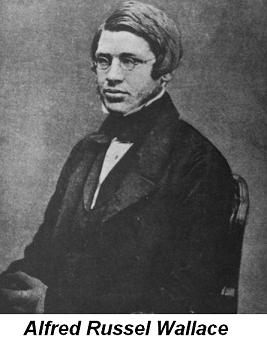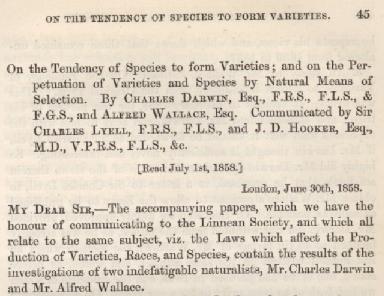
This website is a tribute to the life, work and influence of Charles Darwin. However it would be unfair to omit Alfred Russel Wallace from any discussion of evolution. He co-authored, with Darwin, the first ever publication on natural selection: On the Tendency of Species to Form Varieties; and on the Perpetuation of Varieties and Species by Natural Means of Selection (1858); and is credited with co-discovering natural selection. Yet he is less often remembered than Darwin. So who was Wallace, and what did he do?
Who Was Alfred Russel Wallace?
Wallace was born in a small village in Wales in 1823. He led a very different life from Darwin's. Darwin was born into a wealthy family, and had the opportunity of a university education and a 5 year trip round the world funded by his father. Wallace had no such luck; his family was poor and he had to work for a living. In his early teens he became a building apprentice in London, then moved back to Wales to work as a land-surveyor where he was paid to redraw property boundaries after the Enclosure Act divided previously public owned commons amongst rich land owners (‘legalized robbery of the poor’ to Wallace). This work and time spent in socialist working men’s clubs helped Wallace develop a strong socialist bent which would later influence his scientific work.

Wallace enjoyed working outdoors and read widely, reading many of the same books as Darwin such as Humbolt’s narrative of his tropical journeys, Malthus’ essays on populations, the Vestiges (an early book about evolution), and Darwin’s own journal from the Beagle Voyage. He was inspired! He managed to save enough money to pay to travel to the Brazilian Amazon in 1848 with his friend Henry Walter Bates. Unlike Darwin, when Wallace left England he was already an evolutionist. Also unlike Darwin, he had no money, so had to pay his way by collecting exotic specimens which he sold to collectors. Wallace also built up his own collection, and extensive notes which he planned to write up and publish; unfortunately whilst travelling back to England in 1852, the ship he was on sank along with 4 years worth of work.
Undeterred, after two years of writing articles about what he had seen, he left for a second voyage this time to the Malay Archipelago (now Malaysia and Indonesia). Where he collected both for others and himself, he also described the Wallace Line; the boundary between Australia and Asia which is marked by a big change in the animals found. It was from the Malay Archipelago that Wallace wrote his famous letter to Darwin, which contained an essay outlining a theory very similar to Darwin’s natural selection. Legend has it that the idea came to Wallace during a tropical fever!
What Was His Role In Uncovering Natural Selection?
Wallace and Darwin met briefly before Wallace left on his second trip, and they had previously exchanged a few letters discussing Wallace’s observations abroad. Wallace’s most important letter arrived at Down House on 18th June 1858, by which time Darwin had been sitting on his idea for over 15 years, slowly accumulating evidence, despite warnings from friends (especially Charles Lyell) that he should publish in case someone else has the same idea. When Darwin opened the letter he saw Lyell’s words had ‘come true with a vengeance’.
At this time Darwin’s world was already upside down, some of his children were very ill; one would eventually die. In Wallace’s letter he had asked Darwin to publish his theory if Darwin viewed it favourably, but Darwin was in no state of mind to deal with it immediately so left the matter to his friends Lyell and Hooker to sort out; he wrote to them ‘I hardly care about it… I will do anything’. They decided the fairest course of action was to publish both Wallace’s essay and Darwin’s 1844 essay and extracts of a letter he had written to Harvard botanist Asa Gray together and to announce they had independently made the same conclusions. Since Wallace was still in the Malay Archipelago, he could not be consulted in advance of the publication. However when Wallace replied to Darwin’s letter explaining what was done he wrote that he was very happy to be published jointly with Darwin.

Darwin clearly believed Wallace’s ideas were identical to his own, but there are some differences which in his troubled state of mind, he had not noticed. For example, Darwin always put the emphasis on selection acting on individuals whereas Wallace apparently thought selection acted on groups or species. That selection acts on the individual, due to competition between individuals of the same species, is one of the key points in Darwin’s theory. Whether selection acted for “the good of the group” or on individuals was debated for a long time. Now, however, it is generally accepted that Darwin was right and that selection acts primarily on individuals.
Another apparent difference is that Darwin emphasised competition within populations as the driving force for evolution, whereas Wallace put more emphasis on the species meeting the demands of a change in their environment. Wallace also seemingly disagreed with many of the terms Darwin coined. For example Wallace never appreciated the analogy between evolution and artificial selection which was one of Darwin’s key insights and the source of the term Natural Selection. Wallace even scored out natural selection from his copy of On the Origin of Species and wrote ‘survival of the fittest’ in its place.
In later years the two men differed on other points, for example Darwin invoked other processes than natural selection to explain the evolution of particular characteristics. One of Darwin’s other key theories is sexual selection, which he viewed as an incredibly important process. Wallace however thought its effects were negligible and put more emphasis on natural selection. In his book Darwinism Wallace proposed alternative explanations to many of Darwin’s examples of sexual selection. In the 1970s sexual selection received increased attention from biologists after a long period of being largely forgotten. Work since then has shown that Darwin was right; sexual selection is a key factor in the evolution of many traits.
Darwin and Wallace also disagreed on human evolution. For Darwin, all aspects of humans, including the emotions, conscious mind and intelligence could be explained by natural or sexual selection. By the late 1860s Wallace had become a Spiritualist, and perhaps linked to this, began to reject evolutionary explanations of human intelligence and abilities invoking ‘the unseen universe of Spirit’. This, he claimed, had intervened in the normal run of natural selection three times; at the creation of life, the introduction of consciousness, and the generation of man’s mental capacities. Later in his life Wallace also believed in teleology; the idea that the development of the universe has had a direction and that direction is towards the perfection of man. There are suggestions that Wallace also applied his teleology to evolution. Darwin was clearly a bit perplexed by his former ally’s new views and at one point wrote to Wallace pleading with him not to kill ‘our baby’.
Despite some of Wallace’s more eccentric views on the natural world he made a real contribution to understanding evolution. As well as his own theory of natural selection, Wallace provided new evidence using warning colouration in animals as an example of natural selection. He also developed the theory now known as the Wallace Effect. The Wallace Effect occurs when natural selection favours reproductive isolation between two diverging populations, eventually creating two separate species. This occurs where hybridisation between the two populations produce offspring which are less fit than the offspring of matings within each population. Towards the end of the 19th century natural selection had fallen out of favour with the majority of scientists. However Wallace kept pushing the theory responding to many criticisms in his best known book Darwinism. Wallace was probably one of only two prominent biologists in the 1880s who still placed natural selection as the key to the evolutionary process, the other being August Weismann.
Why Do People Remember Darwin More?
Wallace was undoubtedly a great scientist, who developed his own ideas on evolution in different directions to Darwin, and made a major contribution to our understanding of the natural world. Although we now know how early Darwin began to formulate his theory, Wallace is credited as the co-discoverer of natural selection because they first published their papers together. Wallace’s contribution is remembered; for example, arguably the biggest prize in evolutionary biology is the Darwin-Wallace Medal, awarded by the Linnean Society of London every 50 years on the anniversary of the publication of the 1858 paper for ‘major advances in evolutionary biology’. Both silver and gold medals are awarded; the only gold medal ever awarded was to Wallace in 1908.
However, Darwin does get more credit than Wallace and probably rightly so. The 1858 paper received little attention, it was not until Darwin published On the Origin of Species, which documented huge amounts of evidence which Darwin had collected to support his ideas, that the scientific world took notice. In science no theory is accepted on the basis of argument alone, collecting and presenting evidence is as big an achievement as having the original idea; it is only on the balance of evidence that a theory can be assessed. Darwin was the first to bring together evidence from diverse fields and unite them under one theory.
Darwin also proposed much more than just natural selection, his version of the theory contains many individual theories, each of which he detailed with supporting evidence. He also proposed the important theory of sexual selection, mechanisms for speciation, and applied his ideas across the whole of the living world including humans. His work in different areas, including botany, geology, zoology, anthropology and psychology, have spawned whole new fields and approaches to studying the natural world.
However Wallace’s contribution should be remembered for it is both highly significant and all the more remarkable given Wallace was a self-made man who had some pretty bad spells of bad luck!
What Did Wallace Have To Say About Darwin?
Darwin and Wallace were always gracious and polite to one another; each felt they owed the other for their kindness and each had a great deal of respect for the other. Darwin even helped arrange a Crown pension for Wallace to help sort out his financial difficulties. Their mutual respect didn’t stop the two debating science; Darwin cites Wallace more than anyone else in The Descent of Man, mostly negatively and Wallace criticises sexual selection in his book Darwinism.
Wallace was always gracious over the way Darwin treated the co-publication of their ideas, when he was asked to write about the affair after Darwin’s death he wrote:
‘the friendship between Darwin and myself was sincere, and unbroken to the time of his death… my connection with Darwin and his great work has helped to secure for my own writings on the same questions a full recognition by the press and the public; while my share in the origination and establishment of the theory of Natural Selection has usually been exaggerated. The one great result which I claim for my paper of 1858 is that it compelled Darwin to write and publish his Origin of Species without further delay.’
Written by Stephen Montgomery
References & Further Reading
Alfred Russel Wallace: A Life
by Peter Raby, Pimlico: 2002
The Autobiography of Charles Darwin
by Charles Darwin (Edited by Francis Darwin), The Thinker's Library: 1929
Darwin
by John van Wyhe, Andre Deutsch: 2009
Darwin
by Adrian Desmond & James Moore, Penguin: 1991
Darwinism
by Alfred Russel Wallace, 1889 (any edition)
On the Origin of Species
by Charles Darwin, 1859 (any reprint - 2nd edition preferable)